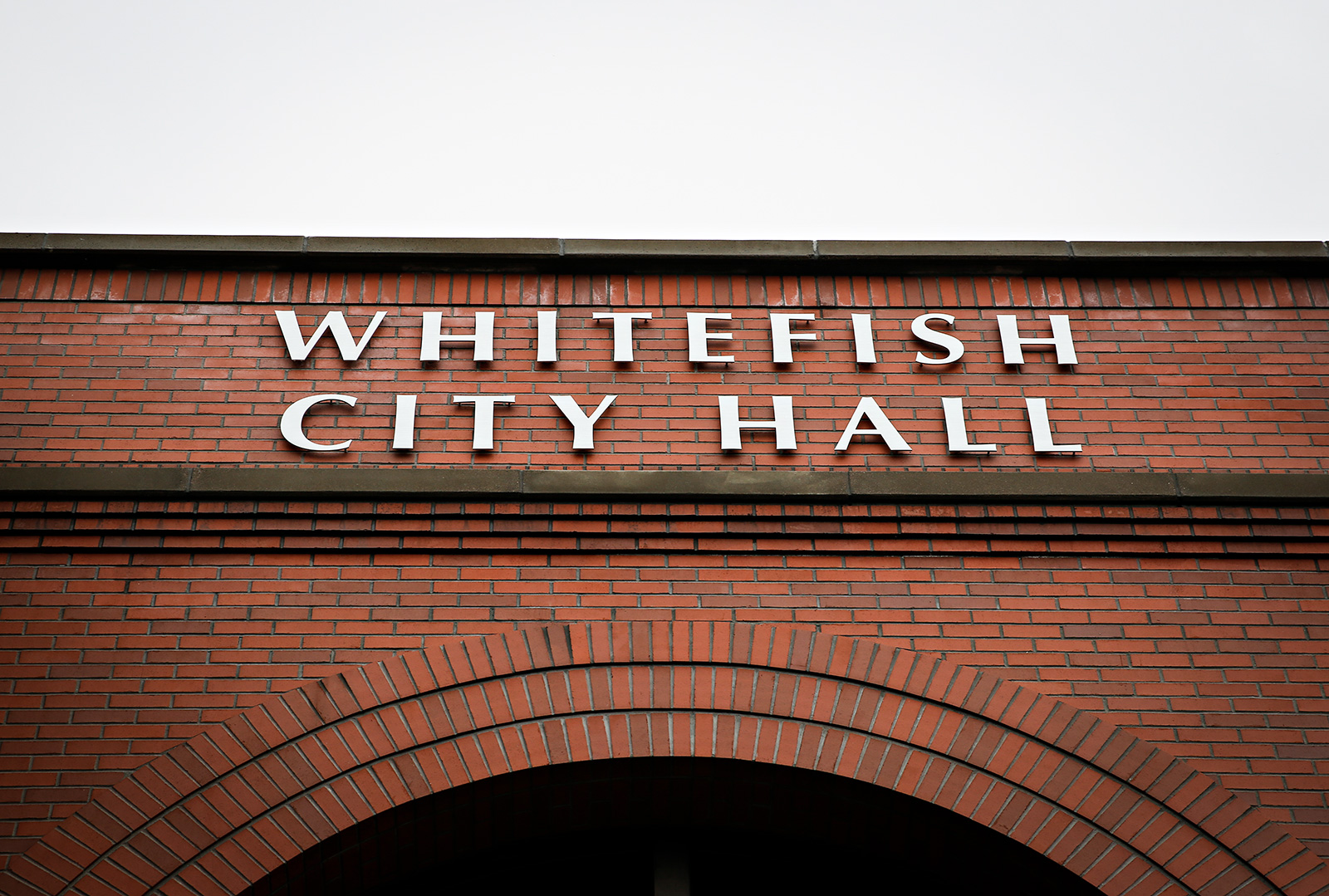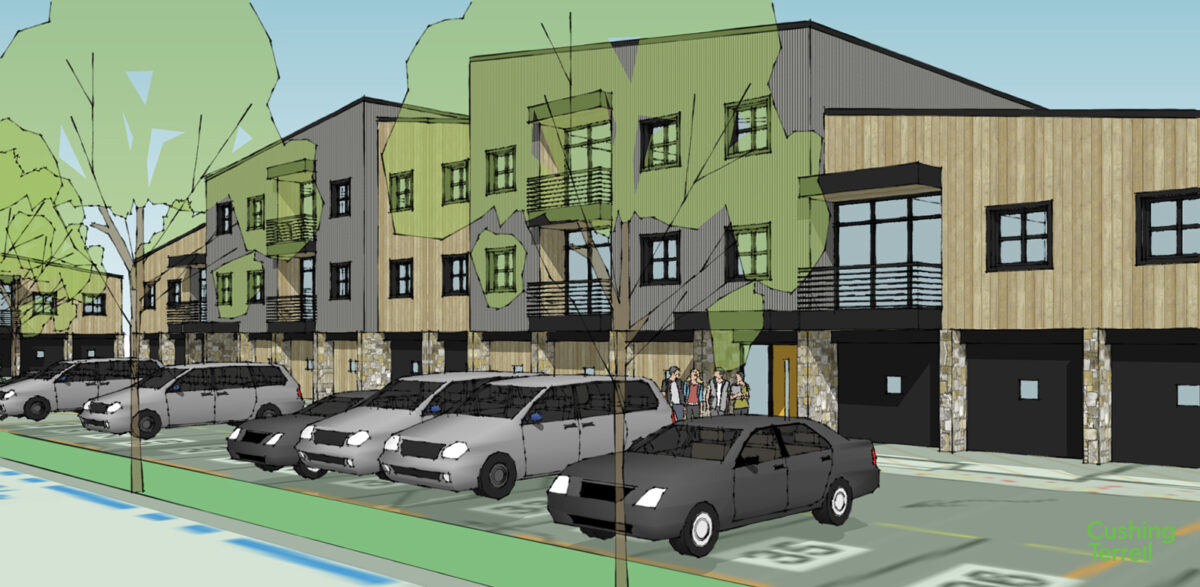Whitefish Planning Board Recommends Approval of 42-Unit Edgewood Place Development
The proposed housing project would include eight affordable units and is located just south of where a 146-unit development was approved by the city council in June
By Mike Kordenbrock
The Whitefish Planning Board at an Oct. 19 meeting recommended the city council approve a zone change and planned unit development request related to a development project that could bring 42 units of housing to about 1.66 acres of land north of the railroad tracks on the 800 block of Edgewood Place.
Backing the project are developers Holbrook McCartney and Whitefish City Councilor Ben Davis, a builder by trade and the owner of Seven Hills Construction. Application materials from the developers show the project including 42 units of multi-family housing through a mix of one- and two-bedroom units spread out across two buildings, with about 21.4% of the land set aside as open space. Units could be apartments or condominiums.
The developers have proposed deed-restricting eight units for permanent affordability, although plans shared with city staff leave the exact nature of those units undetermined. They could be for rent, or condominiums for purchase. If designated for rental, the affordable units would be for people making 60% to 80% of the area median income. If designated for ownership, the affordable units would be for people making between 80% and 120% of the area median income.

The deed-restricted units qualify the project for the city’s Legacy Homes Program, which offers developers who meet criteria for inclusion of affordable housing to certain benefits, like reduced parking requirements, or increased building height.
In this case, the developers have indicated an interest in taking advantage of the benefits allowing a density increase, a height increase — which allows builders to go up to 40 feet in height — and a parking requirement reduction, which would be used to bring parking down from 76 units to 66.
Construction would be in multiple phases, with the first phase involving the construction of 26 units, and a second phase focused on building an additional 16 units. The development will also include a retaining pond to collect stormwater runoff and water.
Currently, the land in question is primarily WLR (one-family limited residential), with a small portion being zoned WR-4 (high-density multifamily). The developers have asked for the zoning to be changed to WR-2 (two-family residential).
Heading into the meeting, city staff had recommended approval of the requests, and determined that it is consistent with the city’s growth policy.
If it moves forward, the project would bring even more density to the area. Directly to the north of the proposed development, Ruis Texco LLC., a company owned by Columbia Falls developer Mick Ruis, was granted approval by the Whitefish City Council in June to build a 146-unit development on 6.55 acres of land on Edgewood Place between Colorado and Texas Avenues. For that project, 44 units will be deed-restricted for permanent affordability.
A Housing Needs Assessment report commissioned by the City of Whitefish in 2022 found that it needs 800 rental units and 515 ownership units by 2030, with about 75% of those units needing to be priced below market rate.
On the zone change, the board members present voted unanimously in favor. The board voted to recommend the planned unit development by a 3-to-1 margin, with Board Chair Steve Qunell, Whitney Beckham and Toby Scott voting in favor, and Scott Freudenberger voting against it.
In explaining his vote, Freudenberger said he believed there could be more housing built if the property was divided into a subdivision with 6,000-square-foot lots for single family homes, and then those properties could also have accessory dwelling units.
Beckham said she was in favor of the zone change, and liked the affordable housing component.
“The property could, with just a zone change, have quite a few changes and that wouldn’t mean we would get so many affordable units,” Beckham said.
But she did express some concerns about the planned unit development. Beckham dismissed the issue of building height, saying that sightlines could be lost by an accessory dwelling unit anyways, but said that she had concerns about the lack of parking in the area.
Qunell also shared some qualms, saying that at first glance he didn’t like seeing someone’s home surrounded by driveways. But he said the board has to look at the overall community benefit, which he said would be the eight affordable units.
“The only way we’re going to solve this problem in our town is by taking what we can get from here and there, and this is not built to what it could be either,” Qunell, who is also a city councilor, said. “The density is less, not by much, but the density is less, and I guarantee you if they just build duplexes there, because that’s what the zoning would be, if we don’t pass the PUD, we’re not going to get any affordable units out of it and it’s going to look pretty dang similar to what’s (going to be) there now.”

Feedback from the handful of people who commented was mixed. Kelly Medelman, who described herself as a 23-year Whitefish resident who works as a waitress and housekeeper, and has owned property on Edgewood Place for three years, said that she has “big concerns” about issues the project could bring, including problems related to groundwater, which already causes basement flooding, as well as building height and traffic. At the same time, Medelman said she believes Davis is “a good neighbor and a good man,” and that she loves the aesthetic.
“But it feels really out-of-proportion to the neighborhood,” Medelman said, adding that she’s no stranger to the community’s need for affordable housing.
Another nearby resident, Rodger Yokota, said he had trouble finding fault, but wanted to “nitpick” the project, and posed questions about the height of the buildings relative to how close they will be to his property line. He also asked for further assurances related to fencing.
Jeremy Harper, who said he was speaking on behalf of his girlfriend who lives nearby but could not attend, repeatedly asked the board who would benefit from the project.
“Who are the people other than Ben Davis and Seven Hills Construction, and the people from out of state that are going to move into these places and fill them up, and clog traffic, and drive in and out of there, and everything else?”
Harper’s concern was something that Mallory Phillips, a board member for the nonprofit Shelter WF, responded to when it was her turn to comment.
“For those who are saying this is just eight affordable apartments, this is eight affordable apartments!” Phillips said. “These are at least eight people who currently cannot find housing in Whitefish, that will be able to find housing in Whitefish, and we should not minimize that.”
For people who are upset about the project, Phillips encouraged them to participate in the city’s ongoing growth policy update, and advocate for density to be dispersed throughout the city so that more neighborhoods can take on growth and change.
The development will come before the Whitefish City Council at its Nov. 6 meeting. That’s the same meeting in which the council will consider approval of an annexation and zone change request for the 210-unit Alpine 93/40 development proposed for an 11.63-acre piece of land near the intersection of U.S. Highway 93 and Montana Highway 40 at the city’s southern gateway.